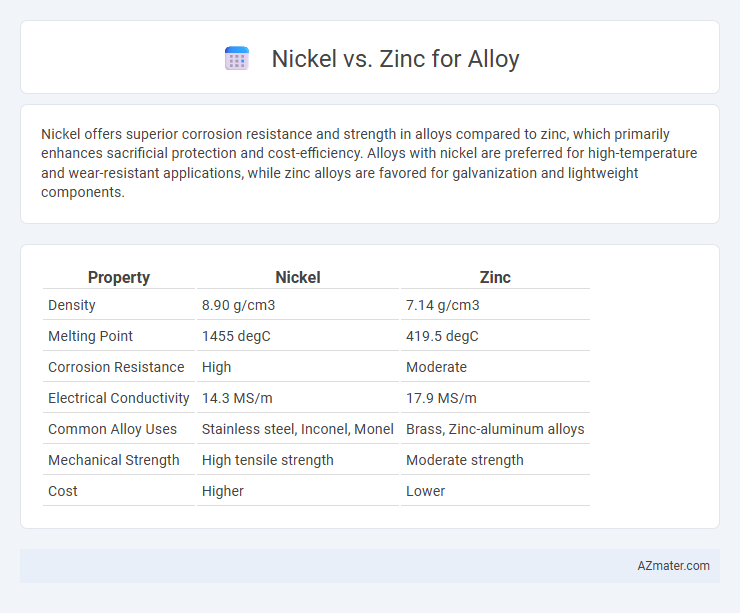Nickel offers superior corrosion resistance and strength in alloys compared to zinc, which primarily enhances sacrificial protection and cost-efficiency. Alloys with nickel are preferred for high-temperature and wear-resistant applications, while zinc alloys are favored for galvanization and lightweight components.
Table of Comparison
| Property | Nickel | Zinc |
|---|---|---|
| Density | 8.90 g/cm3 | 7.14 g/cm3 |
| Melting Point | 1455 degC | 419.5 degC |
| Corrosion Resistance | High | Moderate |
| Electrical Conductivity | 14.3 MS/m | 17.9 MS/m |
| Common Alloy Uses | Stainless steel, Inconel, Monel | Brass, Zinc-aluminum alloys |
| Mechanical Strength | High tensile strength | Moderate strength |
| Cost | Higher | Lower |
Introduction: Nickel vs Zinc Alloys
Nickel alloys exhibit superior corrosion resistance, strength, and thermal stability compared to zinc alloys, making them ideal for high-performance applications in aerospace and automotive industries. Zinc alloys provide excellent castability, cost-effectiveness, and moderate strength, commonly used in die-casting and hardware manufacturing. The choice between nickel and zinc alloys depends on the required mechanical properties, environmental resistance, and budget constraints.
Chemical Properties and Composition
Nickel exhibits excellent corrosion resistance and high tensile strength, making it ideal for alloys requiring durability and resistance to oxidation. Zinc, with its lower melting point and good anti-corrosive properties, is often used in alloys for galvanization and enhancing malleability. Chemical composition differences include nickel's atomic number 28 and valence electrons facilitating strong metallic bonds, while zinc's atomic number 30 and electron configuration promote more reactive and sacrificial corrosion behavior.
Mechanical Strength and Durability
Nickel alloys exhibit superior mechanical strength and enhanced corrosion resistance compared to zinc alloys, making them ideal for high-stress and high-temperature applications. Zinc alloys generally offer good castability and are cost-effective but have lower tensile strength and durability, limiting their use in mechanically demanding environments. The incorporation of nickel in alloy compositions significantly improves wear resistance and longevity, providing better performance in structural and industrial applications.
Corrosion Resistance Comparison
Nickel alloys exhibit superior corrosion resistance compared to zinc alloys, especially in harsh environments such as marine or acidic conditions. Nickel forms a stable, protective oxide layer that prevents further oxidation, while zinc tends to corrode faster due to its sacrificial anode properties. This makes nickel the preferred choice for alloys requiring long-term durability and resistance to chemical degradation.
Conductivity: Electrical and Thermal
Nickel alloys generally exhibit lower electrical conductivity, around 10-25% IACS (International Annealed Copper Standard), compared to zinc alloys, which typically have higher conductivity near 28% IACS depending on composition. Thermal conductivity of nickel is approximately 90 W/m*K, significantly lower than zinc's thermal conductivity of about 116 W/m*K, making zinc alloys more efficient for heat dissipation applications. The conductivity differences influence alloy selection in industries where electrical resistance and thermal management are critical factors.
Cost and Economic Considerations
Nickel alloys generally have a higher upfront cost compared to zinc alloys due to nickel's greater market price and demand in high-performance applications. Zinc alloys offer a more cost-effective solution, with lower raw material and processing expenses, making them suitable for mass production and budget-sensitive projects. Economic considerations should also include the alloy's durability and corrosion resistance, where nickel alloys often provide longer service life, potentially offsetting initial cost differences.
Common Applications in Industry
Nickel alloys are widely used in aerospace and chemical processing industries due to their excellent corrosion resistance and high-temperature strength. Zinc alloys find extensive applications in automotive parts and die-casting because of their good ductility and ease of fabrication. Both metals enhance mechanical properties in alloy formulations but are selected based on specific performance requirements such as strength or corrosion resistance.
Environmental Impact and Sustainability
Nickel alloys generally have a higher environmental footprint than zinc due to energy-intensive mining and refining processes that emit significant greenhouse gases and heavy metals. Zinc, often recovered from recycled sources, offers better sustainability with lower emissions and reduced energy use in alloy production. The durability and corrosion resistance of nickel alloys lead to longer product lifespan, potentially offsetting initial environmental costs compared to zinc-based alloys.
Alloys Formation and Processing Techniques
Nickel forms alloys with excellent corrosion resistance and high-temperature strength, commonly used in stainless steel and superalloys through processes like melting, casting, and powder metallurgy. Zinc alloys, primarily brass and zamak, offer good machinability and corrosion resistance, produced mainly by die casting and continuous casting methods. The choice between nickel and zinc in alloy formation depends on desired mechanical properties, processing techniques, and end-use applications such as automotive, aerospace, and electronics.
Choosing the Right Metal: Nickel or Zinc
Nickel offers superior corrosion resistance and durability, making it ideal for high-performance alloys used in aerospace and automotive industries. Zinc is favored for cost-effective protective coatings and die-casting alloys, providing excellent corrosion protection in construction and hardware applications. Selecting between nickel and zinc depends on factors such as environmental exposure, mechanical requirements, and budget constraints for the intended alloy application.

Infographic: Nickel vs Zinc for Alloy
 azmater.com
azmater.com